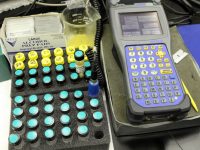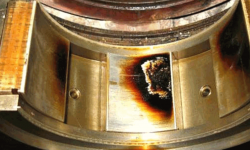Calculating Remaining Useful Life
The field of Predictive Maintenance (PdM) is providing a strong and growing set of tools, techniques and technologies to optimize operations, maintenance and renewal processes of industrial assets. Condition monitoring techniques, in particular, yield valuable insight into the state of health of industrial equipment, providing clues and hints on expected future performance profiles and related risks of performance flaws.
Insight Services has teamed with Cassantec, an independent provider of next-generation predictive offerings for industrial equipment condition monitoring, malfunction risk analysis, remaining lifetime estimation and optimal outage scheduling. Through the use of a leading-edge predictive computational model based on mathematical best practice techniques, Cassantec is able to provide structured, illustrative, quantitative and conclusive insights into expected reliability, remaining useful life (RUL) and latent malfunction risks of equipment, going far beyond conventional PdM offerings.
Cassantec’s Reliability Report is a periodical (e.g. daily) advanced and aggregated profile summary on complex, critical industrial equipment, allowing to schedule targeted service interventions and outages over various time horizons to optimize operations and maintenance processes. We provide this report electronically, either in a PDF format or as a MS Excel tool, including functions for illustration, exploration, validation and testing for reliability managers and in-house condition experts.
How far into the future can we look?
Our Reliability Report provides different prognostic horizons, e.g. a 10, 100 and 1000 day horizon, allowing benefits of optimal outage scheduling in the short, medium and long term. For reliability managers interested in the big picture on their equipment’s condition, the prognostic horizons correspond to zoom levels: a short horizon allows a narrow scope with high resolution, and a long horizon allows a large scope with low resolution.
Prognostic objectives achieved differ depending on the prognostic horizons.
- Explicit predictive information with any prognostic horizon enhances the quality of routine condition monitoring, communication of insights and alarm decisions
- A prognostic horizon of a few days helps to reduce fire fighting and overtime work following an alarm e.g. by allowing to better coordinate an unscheduled outage
- A prognostic horizon of 6 weeks helps to schedule an optimal operational response following an alarm e.g. by moving work orders from an unscheduled to the next scheduled outage
- A prognostic horizon of 2 to 3 years would help to save significant maintenance costs e.g. by extending the operation time between major scheduled outages
- An even longer prognostic horizon could help to determine a cost- and lifetime-optimal equipment replacement and procurement strategy
The length of the prognostic horizon and the quality of the prognosis depend on equipment, malfunctions and condition data considered. Reliability managers and their condition experts get much clarity on their internal reliability objectives by reflecting and discussing the prognostic target horizon for their equipment.
How does this work?
The basis of Cassantec‘s Reliability Report is a predictive computational model based on a novel and unique combination of mathematical best-practice techniques. In particular, the model combines advanced Markovian and Bayesian techniques to determine condition parameter trends, malfunction risk profiles, and remaining useful life (RUL) of critical equipment. Diagnostic and prognostic results are displayed in a decision-oriented report, allowing to identify redundant maintenance tasks and to retain only justifiable service intervention in the outage schedule.
Our computational model is fed by two sets of equipment data:
- A set of historical condition and process data, typically including thermal, vibration and lubricant analysis results. If condition data is insufficient or not archived at all, we may be able to provide comparable condition data from identical equipment models.
- A complete set of up-to-date condition and process data downloaded from the equipment. Condition data updates are necessary for automated updates of the Reliability Report.
Our computational model allows numerous additional simulations, sensitivity analyses and statistical tests to ascertain the robustness of our diagnostic insights, prognostic foresight and recommendations. Some of these functions are offered through the MS Excel versions of our report.
Why is this useful for you?
Cassantec‘s Reliability Report exceeds the benefits of conventional diagnostic reports through its prognostic power, aggregated scope and outage decision focus.
Tangible, quantifiable benefits for maintenance budget providers include:
- Reduced preventive maintenance costs (postponed outages)
- Reduced reactive maintenance costs (malfunctions caught early)
- Reduced fire fighting effort
Benefits for reliability managers include:
- Aggregated diagnostic insights
- Transparent prognostic insights over a 100-day time horizon
- Justifiable outage decisions
Benefits for condition experts include:
- Exchange of experience on important condition parameters
- Shared ownership of alarm decision
- Contribution to next-generation prognostic reporting standards
Hence, a Reliability Report addresses interests of multiple stakeholder groups through a mix of financial, operational and personal incentives, targeting reduced risk, cost and effort of inappropriate maintenance interventions and unexpected outages through advanced diagnostic insights and enhanced prognostic foresight.
Who is Cassantec?
Founded in Zurich, Switzerland in 2007, Cassantec (abbreviated for Cassandra Technologies) provides next-generation predictive technologies for equipment condition monitoring, malfunction risk analysis, remaining lifetime estimation and optimal outage scheduling.
Our technologies are based on a novel blend of best-practice techniques from Operations research, Artificial Intelligence and Data Mining. To render these technologies, Cassantec offers complete software solutions and complementary reporting services for leading companies in the power, chemical, petrochemical, steel, mining and other industries world-wide.
Cassantec is led by an international team of accomplished professionals with strong methodology and technology backgrounds. We are being promoted by the Swiss government’s CTI program, and cooperate with world-renowned universities. References include completed and ongoing collaborations with power and chemical corporations as well as with equipment manufacturers in the U.S.A., Europe and Japan. Cassantec is a strategic cooperation partner of Insight Services in Cleveland, Ohio, U.S.A.






